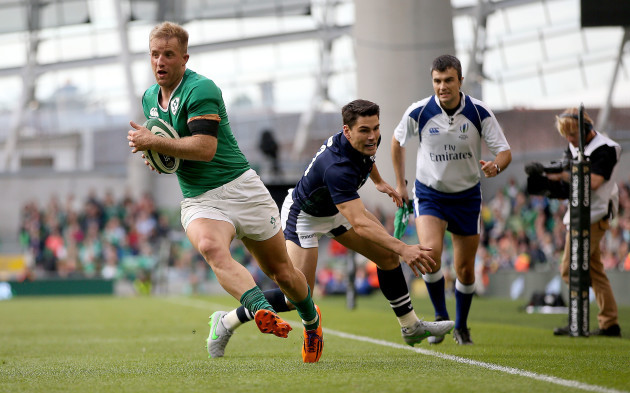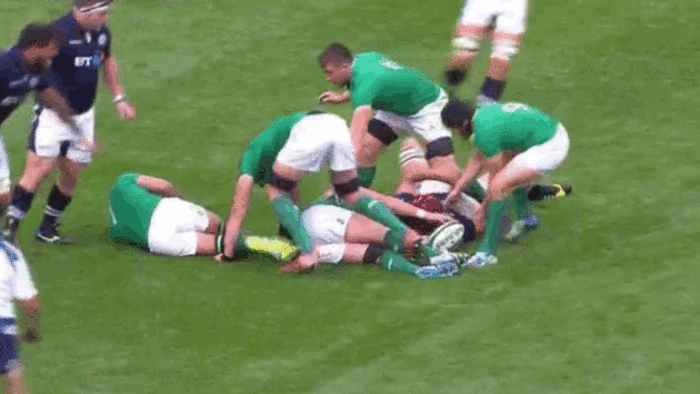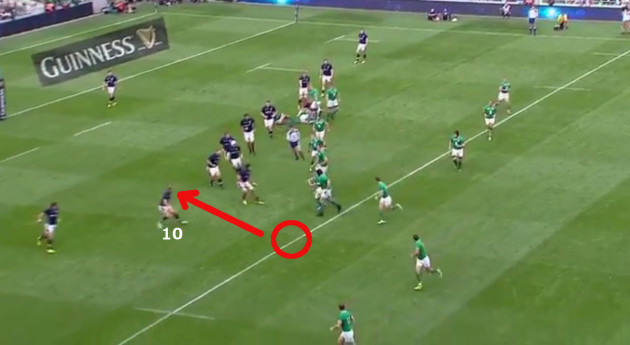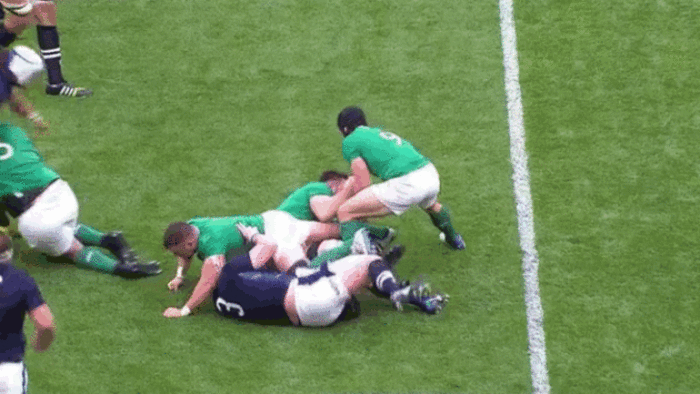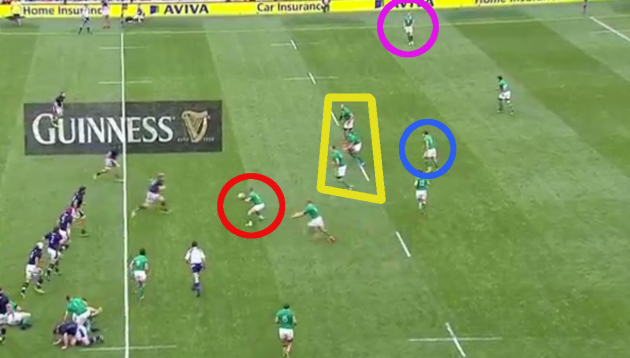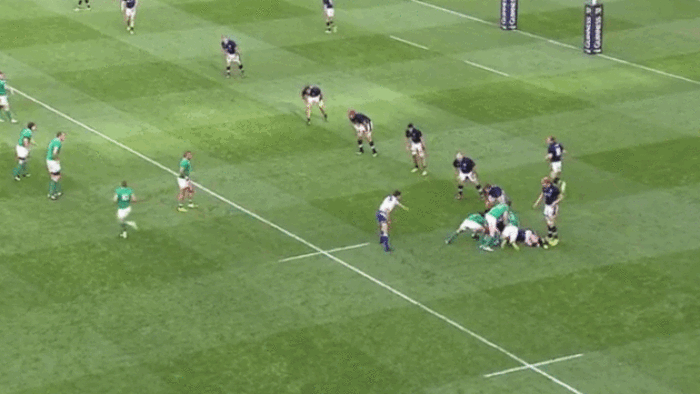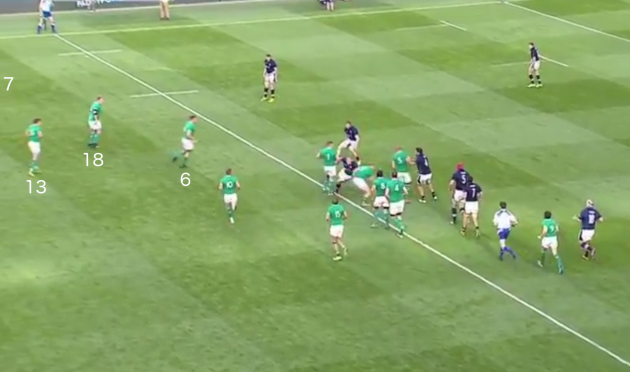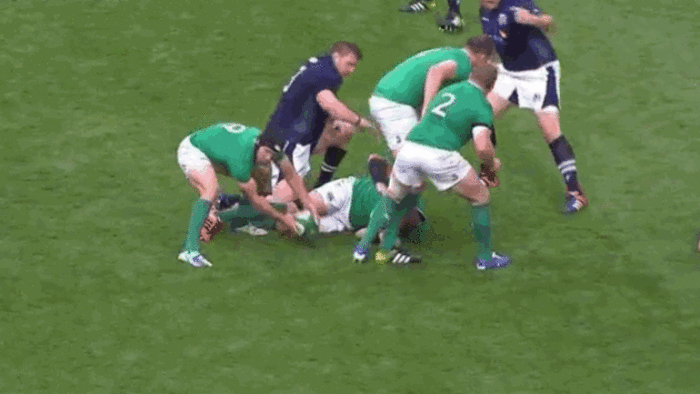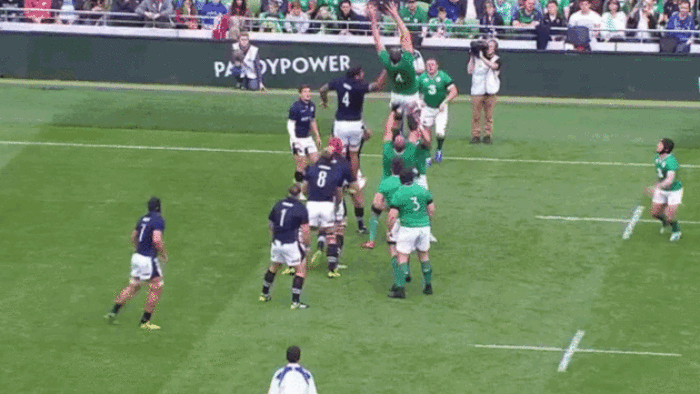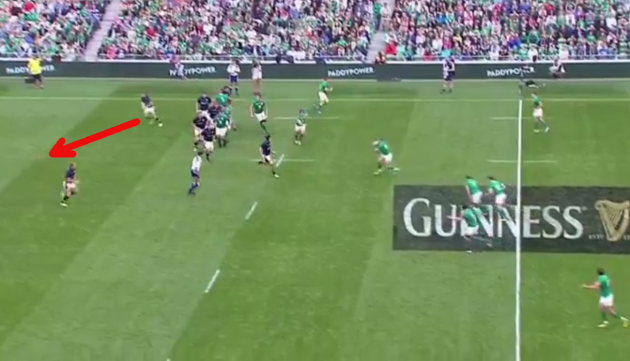JOE SCHMIDT AND Ireland have been keeping a few secrets tucked up their sleeves as the World Cup draws even closer.
It’s hardly surprising; showing your hand at this early stage would be lunacy.
Every team in the competition is holding plays backs, limiting their attacking game plan to varying degrees and generally attempting to ensure that opposition sides don’t have them figured out before a ball is even kicked or passed next month.
Ireland beat Wales with a relatively simple game plan two weekends ago, carrying directly through their centres, using forwards to batter either side of the rucks and winning the lineout with minimum intricacy. Much of that was repeated against Scotland on Saturday.
Sounds similar to the formula that has brought back-to-back Six Nations titles, right? In truth, Ireland haven’t moved too far from what they do best tactically, but it’s a certainty that Schmidt is limiting what they show now.
The power plays Ireland have run in the past two seasons, both those that were successful and some that weren’t, have shown the genius of this Ireland coaching team in terms of building attack.
We haven’t seen anything of their ilk in the two opening games of the season.
Building blocks
The standout attacking moments from Ireland in Dublin last weekend were those two Ian Madigan inside passes – something Schmidt said Ireland had spoken about at half time – and the out-half’s superb cross-field kick.
France, Italy, Romania and Canada will have taken note, but what else might they have picked out of Ireland’s attacking performance? As mentioned above, Ireland largely kept things as basic as possible to allow rusty players to settle in.
That said, there were a few brief glimpses of shape that were of interest.
Ireland’s tactics in and around the opposition 22 are well known at this stage. They most often bludgeon their way to the line, as we saw over the 11 phases that led to Chris Henry’s opening try.
One-out runners with strong support, players leeching, aggressive clear-outs and rapid ruck speed force the defensive team into an uncomfortable position. It’s a successful method and one that a huge number of teams around the world use.
However, against the best defences – Wales in this year’s Six Nations, for example – it doesn’t always work. That makes the shape in the clip above all the more interesting, as Ireland use a linking forward to play out the back door in rugby league style.
Sean O’Brien poses the initial carrying threat, Sean Cronin runs a decoy to his left and draws in Dave Denton, just as O’Brien releases the pass to Madigan.
Suddenly there’s space for Simon Zebo and Luke Fitzgerald, but Scotland’s defensive system works superbly as fullback Ruaridh Jackson advances up into the line and gets a good low tackle in on Fitzgerald to allow Peter Horne to get over the ball.
That draws a penalty as Zebo desperately attempts to rescue the possession, Ireland not having the numbers in position to resource the ruck. Like all other aspects of their play, it’s rusty and a little stilted from Ireland but the actual shape is interesting.
There’s that strained feeling to the example above, as Ireland attempt to set up to run the same shape but this time outside Madigan.
We can see Tommy Bowe running a diagonal line out the back of Cronin this time and the hooker does indeed look back to make the link, but Mike Ross outside him is blocking the opening.
Ideally what Ireland are looking for here is for that whole pod of forwards outside Madigan (Devin Toner, Cronin and Ross) to start slightly wider, with Ross in particular getting up flatter and running an ‘unders’ line outside the linking Cronin.
Had Ross been able to get even a metre wider for his starting position (somewhere around the red circle) and run the straightening decoy line highlighted here, there’s every chance he would have attracted Greig Tonks (marked 10) into checking on him.
That in turn would have allowed Cronin the chance to actually hit Bowe coming onto the ball at speed and heading for a favourable three-on-three on the outside edge.
Minutes after the above example, Ireland used the same shape going from left to right further out the pitch and with more success.
Scotland are in a more compromised position here, particularly as they have a far greater concern for the backfield in covering potential kicks from Ireland, but it’s slicker from Schmidt’s men too.
Again, they play off Madigan (red circle below), with a bank of three forwards in Toner, Chris Henry and Dan Tuohy (highlighted in yellow). Henry is the passing link in the middle of that pod, while Jared Payne (blue) is the back door option for Henry.
Bowe (purple) is holding width on the wide right, as Sean O’Brien looks to provide an extra body in the attacking line just inside Bowe.
The pod of forwards is in a much better position this time, wide and running straight up the pitch rather than arcing around. Tuohy is flat outside Henry, although he could show a little more animation here and possibly tie Richie Vernon down.
The Scotland 13 is able to drift past Tuohy comfortably, but has to address Payne and the space is there for Ireland outside. It’s not as ruthless as you’d like to see come World Cup time out on the right, but the shape that allows the ball to get there is better.
Above, Ireland have Simon Zebo at first receiver with Madigan just back on his feet after being tackled. It’s an interesting element that Zebo adds to the mix for Ireland, whether he’s on the wing or at fullback.
Schmidt seems to back the Munster man to be something of a second playmaker, as we saw for the Felix Jones try in Wales or at stages of last season’s Six Nations.
Here, the shape is familiar to us by now. O’Brien acts as the linking forward in between Toner and Tuohy, with Fitzgerald out the back door. This one will go down as a missed chance on the outside left edge.
Fitzgerald attempts to dance his way through the defence in front of him, but out on the left are Jack Conan (6 below), Nathan White (18), Jared Payne (13) and Henry (7, out of shot).
Had Fitzgerald held just a little more depth in this instance and passed to the left, Ireland were looking at a four-on-three or even a five-on-three if Fitzgerald could have burst outside Gordon Reid.
The positioning of Dave Kilcoyne doesn’t help Fitzgerald however, and that option to the outside is somewhat closed off to the Ireland wing. With more match fitness and sharpness, we’d back Ireland to communicate and scan better if they’re to use this shape in the coming weeks and months.
This use of forwards not only as direct carriers has perhaps been the next obvious development Ireland’s approach to attack was going to make, as they’ve repeatedly added small things to Schmidt’s basic building blocks.
We would stress that Ireland have used these shapes and many others like it before under Schmidt and that a huge number of teams, both professional and amateur, do the same. It’s ensuring that Ireland use them more effectively than anyone else that would be the Schmidt hallmark.
Most teams ideally don’t want their forwards and backs to be completely separate entities in general movement, but instead look to have both sets of players working together intelligently.
Above is an utterly basic screen play from Ireland, but it’s the use of O’Brien away from set-piece or a one-out carry that interests.
The powerful back row doesn’t take any defenders out of the game as such here, but he does attract Denton just enough to ensure the Scotland number eight can’t drift out to Gordon D’Arcy after Payne has drawn in Horne.
Again, the execution on the outside from Ireland is a little sloppy – D’Arcy might have held the ball a little longer – and Scotland’s system copes as scrum-half Pyrgos covers across onto Bowe, but the basic shape in the midfield allows them to make good gains.
Holding back
The prospect of seeing Ireland finally unleash some of the plays they’ve been holding back for the World Cup is a hugely exciting one, although their opposition are sure to have tricks of their own to counter with.
In terms of set-piece strikes and those power plays of old, we’ve not seen too many hints from Ireland. There was, however, one incident against Scotland that made us sit up and take notice.
As with some of the examples we’ve looked at above, the execution from Ireland is not what they’d have hoped for here, but the idea behind the play is fascinating.
It’s a five-man lineout from Ireland and Scotland start with Hugh Blake as their tailgunner, as Pyrgos defends the five-metre channel in the ‘hooker’ position. As soon as the ball is in Madigan’s hands, the scrum-half understandably sets off across the pitch.
Ireland look to play back to that space by switching off Madigan through D’Arcy. Bowe is the final target, but there is the possibility that D’Arcy actually could have taken the ball forward a little more himself again before hitting his right wing.
Instead, Bowe gets the ball some distance away from the departing Scotland pack and they have time to react and cover him. Ahead of the ball Tuohy gets pinged for some blatant blocking on Jim Hamilton.
Ireland are usually clinical with their blocking and interference off the ball, but this whole play speaks volumes of where they are at the moment. Understandably for a side featuring 14 players making their first start of the season, it was at times a scrappy and stilted performance.
They’ll be fitter, sharper, more accustomed to each other and generally better against Wales and England, before launching themselves into the World Cup.
We may not see signs of Schmidt’s true hand until the Italy and France pool games and the tests that will hopefully come thereafter, but we can be certain that Ireland’s execution will be far more clinical.

